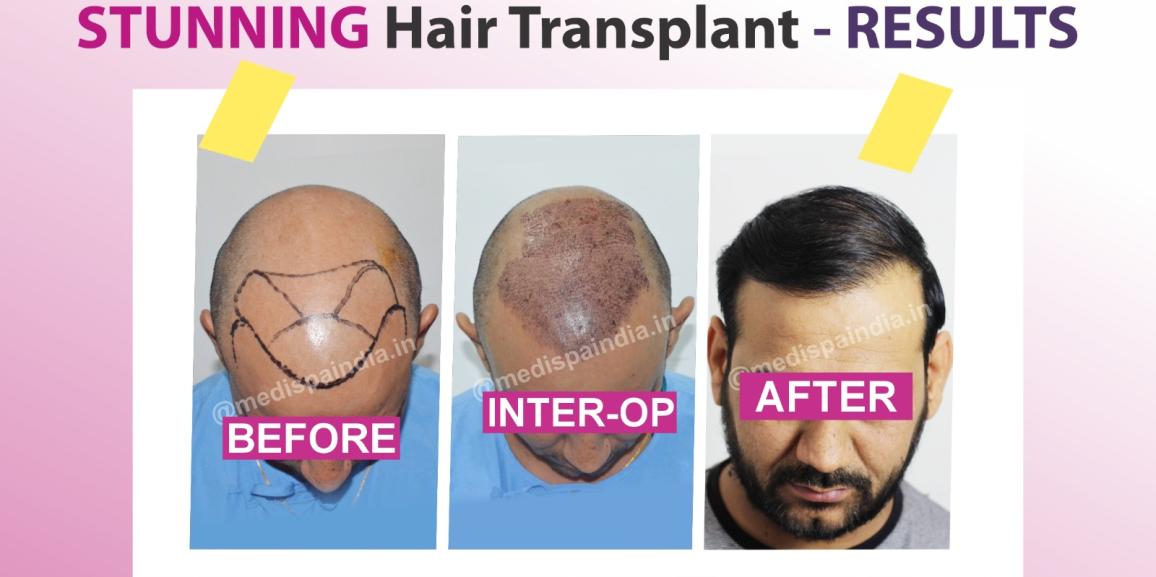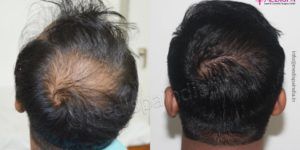
Hair loss has become a significant cosmetic issue for individuals globally in recent times. Initially, many tend to overlook it as it may not be very noticeable. However, as time passes and the loss becomes more apparent, it can be a distressing ordeal. This often leads to feelings of depression as it impacts one’s psychological well-being.
Hair loss progression:
The Norwood classification is widely utilized to determine the severity of hair loss. The stages are outlined below:
Class I: Entire hairline lies high on the forehead and is not actually balding.
Class II: Triangular areas of recession in the sides of frontal area and minimal recession on mid frontal area.
Class III: Borderline case. Deepening of triangular recession or can include thinning of hair on the vertex.
Class IV: Further frontal hair loss and widening of hair loss from vertex but still a wide band of hair present separating frontal and vertex hair loss.
Class V: Widening of frontal and vertex hair loss and continual breaking of separation line of hairs between frontal and vertex baldness.
Class VI: Band or bridge of hair disappear merging frontal and vertex baldness.
Class VII: A band ofhair presents only in back and side of the head.
Hair transplantation surgery is the sole method to permanently address hair loss and remains a highly sought-after cosmetic procedure globally. The selection of treatment for hair loss is dependent on factors such as the extent of baldness, Norwood classification, age, and the condition of hair follicles in the donor area.
Hair transplant procedure
There are various treatments available for baldness, including medications, PRP therapy, and hair transplants. While medications are effective, long-term results are not guaranteed, and hair loss may resume once the medications are discontinued. PRP therapy, on the other hand, is effective but is only recommended in specific cases and has limited use in advanced baldness.
Hair transplantation is typically considered a last resort for addressing baldness. This procedure involves extracting hair follicles from donor areas and implanting them into the desired bald spot. It is an elective procedure, and patients can opt for it at any stage of hair loss.
Although hair transplant in Gurgaon has gained popularity, the city is not widely recognized as a top destination for hair transplant tourism. The hair transplant cost in Gurgaon is higher compared to metropolitan cities like Delhi and Jaipur, which are considered among the best cities for hair transplant tourism. These cities are preferred not only by local patients but also by international patients.
Medispa hair transplant clinic has become a sought-after destination for individuals dealing with hair loss worldwide. We are renowned in the global hair transplant industry for our expertise and exceptional results.
Hair transplant effectivity for high grade baldness
Hair transplant is the sole solution for severe baldness. With the correct approach, method, and treatment planning, hair transplant treatment can effectively address high grade baldness. The Combination technique is considered the most effective method for treating severe baldness. Therefore, let us now delve into the details of the Combination technique, which can yield remarkable results in terms of high density hair growth and a natural appearance.
How was combination technique came into practice?
The creation of the combination technique was a response to the increasing demand for hair transplant procedures with higher densities. Over time, advancements in hair transplant techniques have led to the development of the combination approach, which allows for the harvesting of more hair grafts in a single session. This innovation has significantly expanded the possibilities within the hair transplant industry, offering patients the opportunity to achieve greater density results.
How is the combination technique carried out?
Prior to learning the combination method, it is necessary to have a good understanding of the fundamental primary hair transplant procedures. The FUT hair transplant involves excising a small strip of skin from the donor region and then dissecting it under high magnification to collect each individual hair graft. On the other hand, the FUE procedure entails plucking each hair follicle through the skin using a punch surgical tool of varying diameter, with the aim of reducing scarring by removing each hair follicle individually from a larger interspace.
Now, let’s delve into the combination procedure, which entails performing both the FUT and FUE hair transplants in a single session. These procedures are utilized sequentially to harvest the necessary number of hair grafts. The majority of the required number is obtained using the FUT technique, while the remaining required number of hair follicles is removed using the FUE technique. The combination approach is employed to maximize the number of hair grafts gathered within a single session.
Benefits of combined technique of hair transplant?
The combined procedure is highly beneficial in cases of severe hair loss where a larger number of hair transplants is needed. With this technique, 3000–3500 hair grafts are obtained through the FUT method, while the remaining 2000–2500 hair grafts are extracted using the FUE method, resulting in a total of over 4000 hair grafts.
This approach is particularly advantageous when the surgeon expects further hair loss because, despite the higher yield of hair grafts, the donor site can still be protected for future harvesting. In this method, a 1.5 m strip is cut, leaving approximately 2 cm below it, and then FUE extraction is performed. Consequently, if hair loss persists in relation to the existing hairs, this technique allows for two additional sessions.
Furthermore, this method minimizes damage to the hair grafts as it requires less harvesting compared to FUE, which has a higher likelihood of harming the hair follicles.






